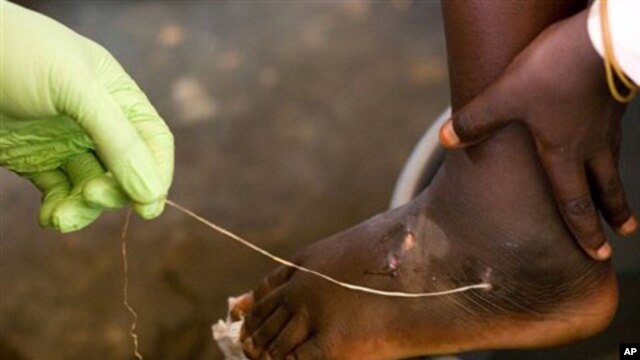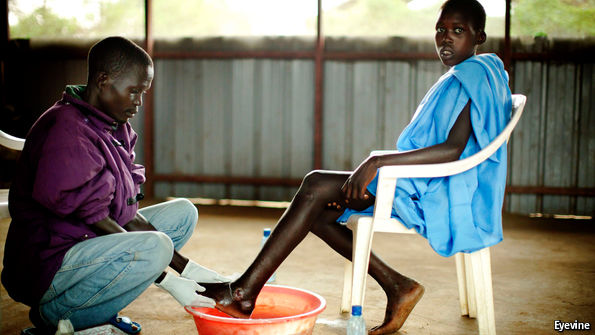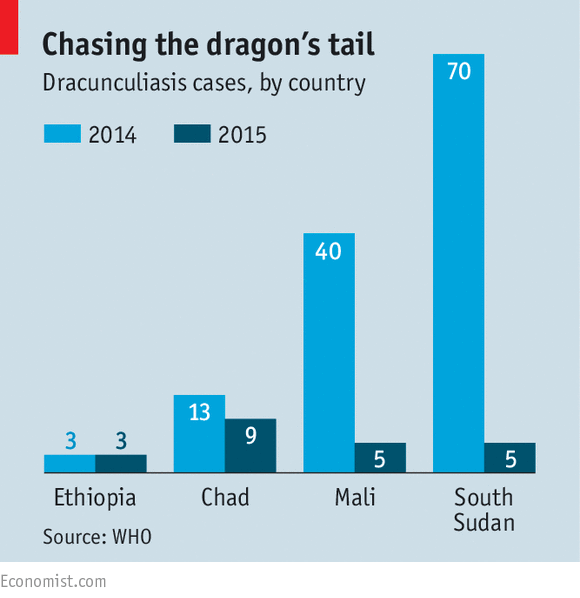1 metre long worm..Shocked to see that! A long wait!

Going, going...
An awful infestation has nearly been wiped out
Feb 6th 2016

IT LOOKS like something out of a Gothic movie: a metre-long monster that emerges slowly through blistered human skin, its victim writhing in agony. No one is spared. It can creep out from between the toes of a child or from the belly of a pregnant woman. In the mid-1980s Dracunculus medinensis, the Guinea worm, as this horror is called, afflicted 3.5m people a year in 20 countries in Africa and Asia. But last year that number was down to just 22, all of them in Chad, Ethiopia, Mali and South Sudan. Dracunculiasis is thus poised to become the second human disease to be eradicated, after smallpox.
This blessed state of affairs is thanks to a 30-year campaign led by the Carter Centre, a charity set up by Jimmy Carter, a former president of America. Mr Carter picked his target well. Most Guinea worms grow in human beings, and their only other host is the domestic dog. Both humans and dogs can be monitored closely, in ways wild animals cannot. This means, in principle, that every case of dracunculiasis can be tracked and the worm involved prevented from reproducing. The task the Carter Centre set itself was to turn this principle into reality.
The worm releases its larvae as it emerges, a process that takes about ten weeks. These larvae normally become infectious only if swallowed by copepods, tiny crustaceans which live in stagnant water. If someone drinks such water, the larvae then migrate to his skin to grow, emerging about a year later. About 90% of worms emerge from the lower part of the leg. Sufferers spread the larvae when they dip their feet in water to relieve the pain.

Breaking this cycle of transmission means doing two things: stopping the larvae reaching copepod-inhabited water, and stopping people ingesting infested copepods. To do so, local volunteers trained by the Carter Centre and its partners spread the message and tend the wounds of those with worms hanging out of them. They also distribute filters of cloth-like mesh for households’ drinking-water buckets, and straw-like filters equipped with a string, so that they can be worn around the neck for people to use when drinking away from home. These filters strain copepods from the water. They, as well as larvicide used for treating water sources suspected of contamination, are all donated by their manufacturers.
These measures—and meticulous surveillance—have brought the Guinea worm close to extinction. Mr Carter’s star power has helped, too. He and his wife, Rosalynn, have travelled to dozens of affected villages, bringing the attention of health ministers and wealthy benefactors to an otherwise neglected disease. In 1995 Mr Carter negotiated the longest humanitarian ceasefire in history: the six-month “Guinea worm ceasefire” in Sudan, which was used to distribute filters, and also medicines and vaccines for other diseases.
Mr Carter says he hopes to outlive the last Guinea worm. Though he is now 91, that is a plausible ambition. All 22 of the worms that were recorded last year have now emerged, and are dead. It is therefore likely that Mali, Ethiopia and South Sudan are now rid of the awful creature, though there needs to be a worm-free period of three years to be sure.
That leaves only Chad, where an unusual development is keeping eradicators on their toes. There, disease detectives found that the worm’s nine human victims last year had ingested the larvae by eating raw fish, rather than by drinking unfiltered water. Worryingly, hundreds of dogs were infested this way, too. Measures to prevent new cases were swiftly deployed. Eradication teams have been urging people to make sure the fish they eat is fully cooked, to bury raw fish entrails (to prevent dogs from eating them) and to tether infested canines.
The Carter Centre’s field workers reckon people are 70-80% compliant with the second and third measures on this list. Compliance with the first is harder to estimate, since it would mean a mass invasion of people’s kitchens. Whether these measures will be enough to break the chain of transmission remains to be seen. But those workers’ vigilance is such that any new cases, whether human or canine, are likely to be noticed quickly. With luck, it will not be long before the world’s last Guinea worm becomes a celebrity—preserved for posterity in a formalin-filled jar at the Carter Centre’s headquarters, in Atlanta.
http://www.economist.com/news/scien...-havoc-wreaks-has-nearly-been-wiped-out-world

Going, going...
An awful infestation has nearly been wiped out
Feb 6th 2016

IT LOOKS like something out of a Gothic movie: a metre-long monster that emerges slowly through blistered human skin, its victim writhing in agony. No one is spared. It can creep out from between the toes of a child or from the belly of a pregnant woman. In the mid-1980s Dracunculus medinensis, the Guinea worm, as this horror is called, afflicted 3.5m people a year in 20 countries in Africa and Asia. But last year that number was down to just 22, all of them in Chad, Ethiopia, Mali and South Sudan. Dracunculiasis is thus poised to become the second human disease to be eradicated, after smallpox.
This blessed state of affairs is thanks to a 30-year campaign led by the Carter Centre, a charity set up by Jimmy Carter, a former president of America. Mr Carter picked his target well. Most Guinea worms grow in human beings, and their only other host is the domestic dog. Both humans and dogs can be monitored closely, in ways wild animals cannot. This means, in principle, that every case of dracunculiasis can be tracked and the worm involved prevented from reproducing. The task the Carter Centre set itself was to turn this principle into reality.
The worm releases its larvae as it emerges, a process that takes about ten weeks. These larvae normally become infectious only if swallowed by copepods, tiny crustaceans which live in stagnant water. If someone drinks such water, the larvae then migrate to his skin to grow, emerging about a year later. About 90% of worms emerge from the lower part of the leg. Sufferers spread the larvae when they dip their feet in water to relieve the pain.

Breaking this cycle of transmission means doing two things: stopping the larvae reaching copepod-inhabited water, and stopping people ingesting infested copepods. To do so, local volunteers trained by the Carter Centre and its partners spread the message and tend the wounds of those with worms hanging out of them. They also distribute filters of cloth-like mesh for households’ drinking-water buckets, and straw-like filters equipped with a string, so that they can be worn around the neck for people to use when drinking away from home. These filters strain copepods from the water. They, as well as larvicide used for treating water sources suspected of contamination, are all donated by their manufacturers.
These measures—and meticulous surveillance—have brought the Guinea worm close to extinction. Mr Carter’s star power has helped, too. He and his wife, Rosalynn, have travelled to dozens of affected villages, bringing the attention of health ministers and wealthy benefactors to an otherwise neglected disease. In 1995 Mr Carter negotiated the longest humanitarian ceasefire in history: the six-month “Guinea worm ceasefire” in Sudan, which was used to distribute filters, and also medicines and vaccines for other diseases.
Mr Carter says he hopes to outlive the last Guinea worm. Though he is now 91, that is a plausible ambition. All 22 of the worms that were recorded last year have now emerged, and are dead. It is therefore likely that Mali, Ethiopia and South Sudan are now rid of the awful creature, though there needs to be a worm-free period of three years to be sure.
That leaves only Chad, where an unusual development is keeping eradicators on their toes. There, disease detectives found that the worm’s nine human victims last year had ingested the larvae by eating raw fish, rather than by drinking unfiltered water. Worryingly, hundreds of dogs were infested this way, too. Measures to prevent new cases were swiftly deployed. Eradication teams have been urging people to make sure the fish they eat is fully cooked, to bury raw fish entrails (to prevent dogs from eating them) and to tether infested canines.
The Carter Centre’s field workers reckon people are 70-80% compliant with the second and third measures on this list. Compliance with the first is harder to estimate, since it would mean a mass invasion of people’s kitchens. Whether these measures will be enough to break the chain of transmission remains to be seen. But those workers’ vigilance is such that any new cases, whether human or canine, are likely to be noticed quickly. With luck, it will not be long before the world’s last Guinea worm becomes a celebrity—preserved for posterity in a formalin-filled jar at the Carter Centre’s headquarters, in Atlanta.
http://www.economist.com/news/scien...-havoc-wreaks-has-nearly-been-wiped-out-world
